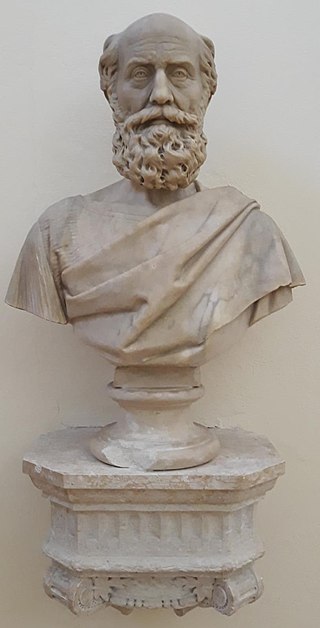
The redwing is a bird in the thrush family, Turdidae, native to Europe and the Palearctic, slightly smaller than the related song thrush.

The psoas major is a long fusiform muscle located in the lateral lumbar region between the vertebral column and the brim of the lesser pelvis. It joins the iliacus muscle to form the iliopsoas. In animals, this muscle is equivalent to the tenderloin.

Aemilius Macer of Verona was a Roman didactic poet. He authored two poems, one on birds (Ornithogonia), a translation of a work by Boios, and the other on the antidotes against the poison of serpents (Theriaca), which he imitated from the Greek poet Nicander of Colophon. According to Jerome, he died in 16 BC. It is possible that he wrote also a botanical work. The extant hexameter poem known as Floridus or De viribus herbarum, traditionally ascribed to Macer, is actually a medieval production by Odo Magdunensis, a French physician.

The iliacus is a flat, triangular muscle which fills the iliac fossa. It forms the lateral portion of iliopsoas, providing flexion of the thigh and lower limb at the acetabulofemoral joint.

The iliopsoas muscle refers to the joined psoas major and the iliacus muscles. The two muscles are separate in the abdomen, but usually merge in the thigh. They are usually given the common name iliopsoas. The iliopsoas muscle joins to the femur at the lesser trochanter. It acts as the strongest flexor of the hip.
The linea aspera is a ridge of roughened surface on the posterior surface of the shaft of the femur. It is the site of attachments of muscles and the intermuscular septum.

In human anatomy, the muscles of the hip joint are those muscles that cause movement in the hip. Most modern anatomists define 17 of these muscles, although some additional muscles may sometimes be considered. These are often divided into four groups according to their orientation around the hip joint: the gluteal group; the lateral rotator group; the adductor group; and the iliopsoas group.

The arcuate line of the ilium is a smooth rounded border on the internal surface of the ilium. It is immediately inferior to the iliac fossa and Iliacus muscle.
In human anatomy, the body of femur is the almost cylindrical, long part of the femur. It is a little broader above than in the center, broadest and somewhat flattened from before backward below. It is slightly arched, so as to be convex in front, and concave behind, where it is strengthened by a prominent longitudinal ridge, the linea aspera.

The wing(ala)of ilium is the large expanded portion of the ilium, the bone which bounds the greater pelvis laterally. It presents for examination two surfaces—an external and an internal—a crest, and two borders—an anterior and a posterior.

Medial to the anterior inferior iliac spine is a broad, shallow groove, over which the iliacus and psoas major muscles pass. This groove is bounded medially by an eminence, the iliopubic eminence, which marks the point of union of the ilium and pubis.

The crest of the ilium is the superior border of the wing of ilium and the superiolateral margin of the greater pelvis.

The iliac fascia is the fascia overlying the iliacus muscle.

The iliac fossa is a large, smooth, concave surface on the internal surface of the ilium.

The anterior compartment of thigh contains muscles which extend the knee and flex the hip.

The iliac branch of the iliolumbar artery descends to supply the iliacus muscle; some offsets, running between the muscle and the bone, anastomose with the iliac branches of the obturator artery; one of these enters an oblique canal to supply the bone, while others run along the crest of the ilium, distributing branches to the gluteal and abdominal muscles, and anastomosing in their course with the superior gluteal artery, iliac circumflex artery, and the lateral circumflex femoral artery. This anastamosis occurs around the anterior superior iliac spine.
Etaxalus is a genus of longhorn beetles of the subfamily Lamiinae, containing the following species:
Etaxalus granulipennis is a species of beetle in the family Cerambycidae. It was described by Stephan von Breuning in 1953.
Etaxalus laterialbus is a species of beetle in the family Cerambycidae. It was described by Stephan von Breuning in 1968.
Etaxalus rotundipennis is a species of beetle in the family Cerambycidae. It was described by Stephan von Breuning in 1976.












